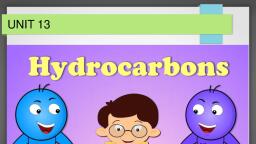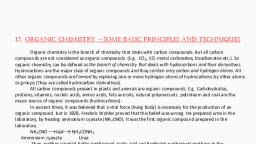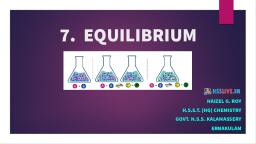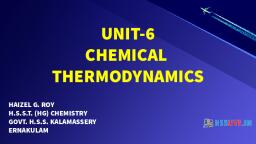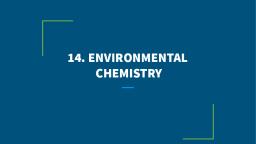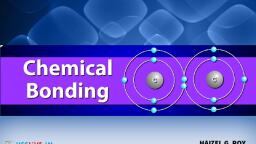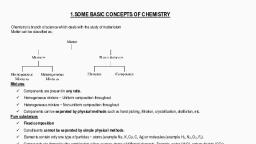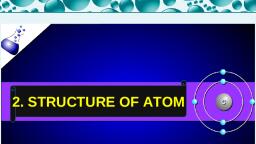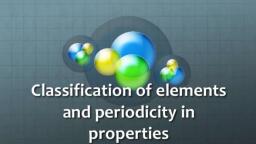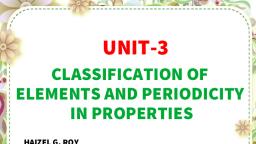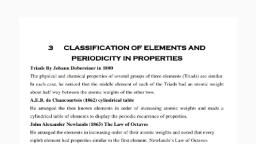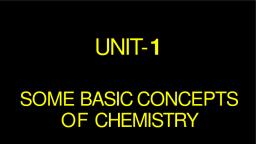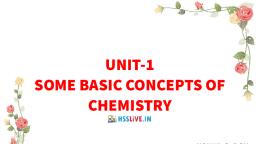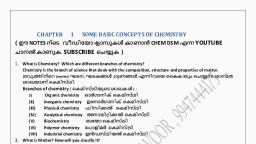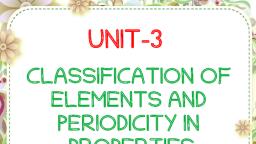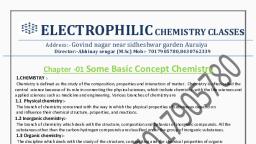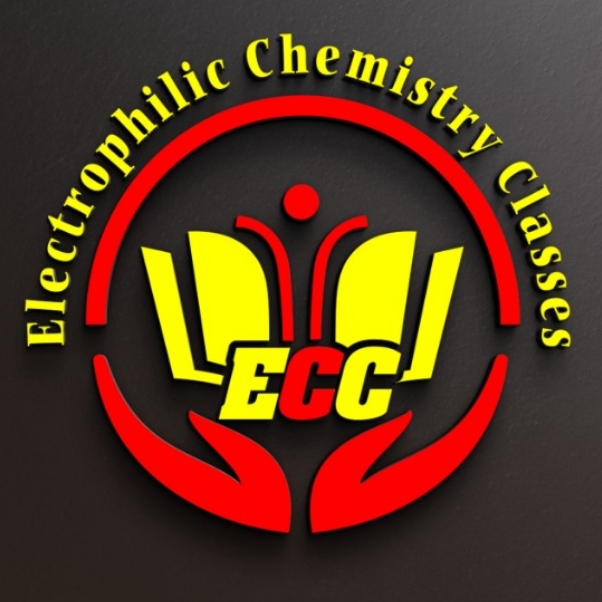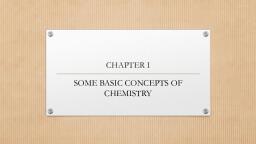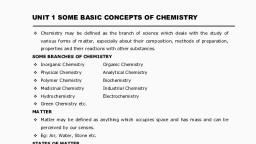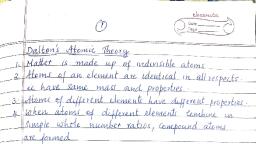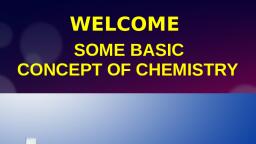Page 1 :
UNIT-1, SOME BASIC CONCEPTS, OF CHEMISTRY
Page 2 :
Chemistry, The branch of science which deals, with the composition, structure and, properties, , of, , matter, , and, , the, , changes which matter undergoes.
Page 3 :
Branches of Chemistry, , ✔, , Inorganic Chemistry, , ✔, , Medicinal Chemistry, , ✔, , Organic Chemistry, , ✔, , Industrial Chemistry, , ✔, , Physical Chemistry, , ✔, , Hydrochemistry, , ✔, , Analytical Chemistry, , ✔, , Electrochemistry, , ✔, , Polymer Chemistry, , ✔, , Green Chemistry, , ✔, , Biochemistry, , ✔, , Pharmaceutical Chemistry
Page 4 :
MATTER, Anything which occupies space and, has mass and can be perceived by, our senses., Eg: Air, Water, Stone etc.
Page 5 :
STATES OF MATTER, , , Solid state, , , , Liquid state, , , , Gaseous state, , , , Plasma state, , , , Bose-Einstein condensate, , , , Fermionic condensate
Page 6 :
CLASSIFICATION OF MATTER, , 1. PHYSICAL CLASSIFICATION, , 2. CHEMICAL CLASSIFICATION
Page 7 :
PHYSICAL CLASSIFICATION, , SOLIDS, , GASES, LIQUIDS
Page 8 :
Solids, , , Have definite mass, volume and shape., , , , The constituent particles are tightly packed, , , , Intermolecular distances are short., , , , Intermolecular forces are strong., , , , Constituent particles have fixed positions., , , , They can only oscillate about their mean positions., , , , Incompressible and rigid.
Page 9 :
Liquids, , , Liquids are not rigid, but have definite volume., , , , They do not have a definite shape., , , , They take the shape of the container in which they, are placed., , , , The constituent particles are loosely packed., , , , The, , intermolecular, , distances, , will, , be, , large, , compared to that of solids., , , Intermolecular forces are weak compared to solids., , , , The rate of diffusion will be greater than solids., , as
Page 10 :
Gases, , , Gases have neither definite shape nor definite volume., , , , The particles are far apart from one another., , , , The intermolecular distances are very large., , , , The intermolecular forces of attraction are very weak., , , , Gases are highly compressible., , , , Gases exert pressure equally in all directions., , , , Gases have much lower density than solids and liquids., , , , Gases mix evenly and completely in all proportions, without any mechanical aid.
Page 12 :
CHEMICAL CLASSIFICATION, , ELEMENTS, , MIXTURES, , COMPOUNDS
Page 13 :
ELEMENTS, , , An element is a pure substance., , , , It cannot be broken down into two, or, , more, , simpler, , substances, , by, , physical andchemical means., , , It is made up of only one kind of, atom., , , , Eg: Copper, Silver, Gold, Iron etc..
Page 15 :
COMPOUNDS, , , A compound is a pure substance., , , , It is made up of two or more, elements combined chemically in, fixed proportion., , , , Eg: H2O, NH3 , CH4 etc.
Page 17 :
MIXTURES, , A mixture is made up of two or more, elements or compounds or both., Eg: Brass is a mixture of Cu and Zn., Bronze is a mixture of Cu and Sn.
Page 19 :
CLASSIFICATION OF MIXTURES
Page 20 :
HOMOGENEOUS MIXTURE, , , In, , a, , homogeneous, , components, , mixture,, , completely, , mix, , the, with, , each other., , , Its, , composition, , is, , uniform, , throughout the mixture., , , , , Eg: Ethanol – Water mixture, Salt solution, sugar solution etc.
Page 22 :
HETEROGENEOUS MIXTURE, , , The constituent particles are not uniformly, mixed., , , , The, , properties, , and, , composition, , vary, , throughout the mixture., , , Eg: Gun powder is a mixture of charcoal,, sulphur and nitre., , , , Muddy water, Chalk powder in water etc.
Page 23 :
GUN POWDER, , CHALK POWDER IN WATER, , SAND IN WATER
Page 24 :
PROPERTIES OF MATTER
Page 25 :
PHYSICAL PROPERTIES, Properties which can be measured or, observed without changing the identity, or the composition of the substance., Eg: Colour, odour, melting point, boiling, point, density etc.
Page 26 :
CHEMICAL PROPERTIES, , Properties in which a chemical change, occur., Eg:, , Chemical, , substances., , reactions, , of, , different
Page 27 :
MASS, , Mass of a substance is the amount of, matter present in it., The mass of a substance is constant., The SI unit of mass is kg.
Page 28 :
WEIGHT, , , , Weight is the force exerted by gravity on, an object., , , , Weight may vary from one place to, another due to change in gravity.
Page 29 :
DENSITY, , , , Density of a substance is the amount of, mass per unit volume., , , The SI unit of density is kg/m3
Page 30 :
TEMPERATURE, , , Temperature is the degree of hotness of a, body., , , , Three, , common, , scales, , measure temperature., , , Degree Celsius (0C), , , , Degree Fahrenheit (0F), , , , Kelvin (K)., , are, , used, , to
Page 31 :
, , The Celsius scale is represented between zero, degree to hundred degree Celsius., , , , Fahrenheit scale is represented between 32, , 0, , to, , 2120 F., , , The Fahrenheit scale is related to Celsius scale as, follows, , , , , , The Kelvin scale is related to Celsius scale as, follows, K=, , 0, , C + 273.15
Page 32 :
ACURACY & PRECISION, ACCURACY is the agreement of a particular value to, the true value of the result., PRECISION is the closeness of various measurements, for the same quantity., Eg: If the true value for a result is 2.00 g and a, student ‘A’ takes two measurements and reports the, result as 1.95 g and 1.93 g. These values are precise, but are not accurate.
Page 33 :
SIGNIFICANT FIGURES, , Significant figures are meaningful digits, which are known with certainty.
Page 34 :
RULES FOR DETERMINING SIGNIFICANT FIGURES, 1. All non zero digits are significant., Eg: 235 has 3 significant figures., 2. Zero’s to the left of the first non zero digit are not, significant., Eg: 0.002 has only one significant figure., 3. Zero’s between non zero digits are significant., Eg: 3.02 has 3 significant figures., 4. Zero’s to the right of the decimal point are, significant., Eg: 2.00 has 3 significant figures.
Page 35 :
LAWS OF CHEMICAL, COMBINATION
Page 36 :
LAW OF CONSERVATION OF MASS, Matter can neither be created nor be, destroyed., , Eg: 12 g carbon combines, with 32 g oxygen to form, 44 g CO2. Here the total, mass of the reactants is, equal to the total mass of, the products., , Antoine Lavoisier
Page 37 :
LAW OF DEFINITE PROPORTION, The same compound always contain the, same elements combined in the same, fixed proportion by mass., , Eg: NaCl may be obtained from sea, water. It is also prepared by chemical, reactions, , between, , NaOH, , and, , HCl., , These samples on analysis are found, to contain Na and Cl in the ratio, , Joseph Proust, , 23:35.5 by mass.
Page 38 :
LAW OF MULTIPLE PROPORTION, when two elements combines to form more than one, compound, the different masses of one of the elements, which combines with a fixed mass of the other element, are in the ratio of simple whole numbers., , Eg:Carbon, different, , combines, oxides, , CO, , with, and, , oxygen, CO2, , to, , under, , form, , two, , different, , conditions. In CO2, 12 g of carbon combines with 32 g, of oxygen and in carbon monoxide 12 g carbon, combines with 16g of oxygen. In these two cases, the, mass of oxygen combining with the fixed mass of, , John Dalton, , carbon are in the ratio 16:32 or 1:2.
Page 39 :
GAY LUSSAC'S LAW, when gases combine to form gaseous products, a, simple ratio exists between the volumes of the, reactants and the products at constant temperature, and pressure., , Eg: When H and Cl combine to, form HCl, a simple ratio by, volume exists between the gases, H2, Cl2 and HCl at constant, temperature and pressure., John Louis Gay Lussac
Page 40 :
AVOGADRO'S LAW, Equal volume of all gases under the same, conditions of temperature and pressure, contains the same number of molecules., , Avogadro
Page 41 :
DALTON'S ATOMIC THEORY, 1. Matter is made up of small indivisible particles, called atoms., 2. Atoms of the same element are identical in mass, and other properties., 3. Atoms of different elements are different in mass, and other properties., 4. Atoms can neither be created nor be destroyed., 5. Since atoms are indivisible, they combine in small, whole numbers to form compound atoms called, molecules.
Page 42 :
ATOMS & MOLECULES, An atom is the smallest possible unit of, matter that exhibits all the properties of, matter, , that, , may, , or, , may, , not, , have, , independent existence., A molecule is the smallest unit of matter, which exhibits all the properties of that, kind, , of, , matter, , and, , independent existence., , is, , capable, , of
Page 43 :
TYPES OF MOLECULES, A molecule containing only one type of, atom is called homonuclear molecule., Eg. H , O , N , O etc., 2, 2, 2, 3, , , Molecules containing different types of, atoms are called Heteronuclear molecules, E.g. CO , H O, C H O , NH etc., 2, 2, 6 12 6, 3,
Page 44 :
TYPES OF MOLECULES, Based on the number of atoms, there are three, types of molecules, , Monoatomic molecules contain only one atom., , Eg. All metals, noble gases like He, Ne, Ar etc., , Diatomic molecules contain 2 atoms., E.g. H , O , N , halogens (F , Cl , Br and I ), 2, 2, 2, 2, 2, 2, 2, , , Polyatomic molecules contain more than two, atoms., Eg. ozone (O ), Phosphorus (P ), Sulphur (S ), 3, 4, 8, etc.,
Page 45 :
ATOMIC MASS, Atomic mass of an element is defined as a, number which expresses how many times, the mass of one atom of the element is, greater than, , mass of a carbon-12 atom.
Page 46 :
ATOMIC MASS UNIT, One atomic mass unit is defined as mass, exactly equal to, , the mass of one carbon-, , 12 atom. amu is also known as unified mass, (u)., 1 amu = 1.66056 x 10, , -24
Page 47 :
MOLECULAR MASS, , , Molecular mass is the sum of atomic masses, of the elements present in a molecule., , , , It is obtained by multiplying the atomic mass, of each element by the number of its atoms, and adding them together.
Page 48 :
GRAM ATOMIC MASS OR GRAM ATOM, Atomic mass expressed in grams is called, gram atomic mass or simply gram atom.
Page 49 :
GRAM MOLECULAR MASS OR GRAM MOLE, , The molecular mass expressed in grams is, called gram molecular mass or simply gram, mole.
Page 50 :
FORMULA MASS, The formula mass of a molecule is the sum, of the atomic weights of the atoms in the, empirical formula of the concept., Eg: The formula mass of NaCl = Atomic, mass of sodium + Atomic mass of Cl, = 23 + 35.5 = 58.5
Page 51 :
MOLE CONCEPT, Mole is the unit used for counting, very large number of particles like, atoms, molecules or ions., This is equal to 6.023 x 1023., Mole is represented by the symbol, ‘mol’.
Page 52 :
MOLAR VOLUME, The volume occupied by one mole of a, gas is called molar volume or gram, molar volume., One mole of all gases occupies 22.4 L, at STP.
Page 53 :
PERCENTAGE COMPOSITION
Page 54 :
EMPIRICAL FORMULA, An empirical formula represents the, simplest, , whole, , various, , atoms, , number, present, , ratio, , of, , in, , a, , compound., Eg: Empirical formula of Benzene is, CH.
Page 55 :
MOLECULAR FORMULA, Molecular formula gives the exact, number of different types of atoms, present in a molecule of a compound., Eg: Molecular formula of Benzene is, C 6 H 6.
Page 56 :
RELATION BETWEEN EMPIRICAL, AND MOLECULAR FORMULA, , Molecular formula = n x Empirical Formula
Page 57 :
STOICHIOMETRY, The word Stoichiometry is defined from two, Greek words., ‘stoichion’ meaning element and ‘metron’, meaning measure., Stoichiometry deals with the calculation of, masses of the reactants and the products, involved in a chemical reaction.
Page 59 :
REACTIONS IN, SOLUTIONS
Page 60 :
MASS PERCENT, Mass percentage of a component in a, given, , solution, , is, , the, , mass, , of, , compound per 100g of the solution., , the
Page 61 :
MOLE FRACTION, It is the ratio of number of moles of a particular component to, the total number of moles of the solution., , If a substance ‘A’ dissolves in a substance ‘B’ and their number, of moles are nA and nB respectively. Then the mole fractions of A, and B are given as
Page 62 :
MOLARITY, It is defined as the number of moles, of the solute in one litre of the, solution., It is denoted by 'M'
Page 63 :
MOLALITY, The number of moles of solute, present in 1 kg of solvent., It is denoted by ‘m’.
Page 64 :
NORMALITY, It is defined as the number of gram, equivalents of the solute dissolved, in one litre of the solution., It is denoted by 'N'
Page 65 :
LIMITING REACTANT, OR LIMITTING REAGENT, , The, , reagent, , which, , is, , completely, , consumed in a chemical reaction is called, limiting reactant or limiting reagent.
Page 66 :
THANK, YOU, HAIZEL G. ROY, H.S.S.T. (HG) CHEMISTRY, GOVT. H.S.S., KALAMASSERY, ERNAKULAM
